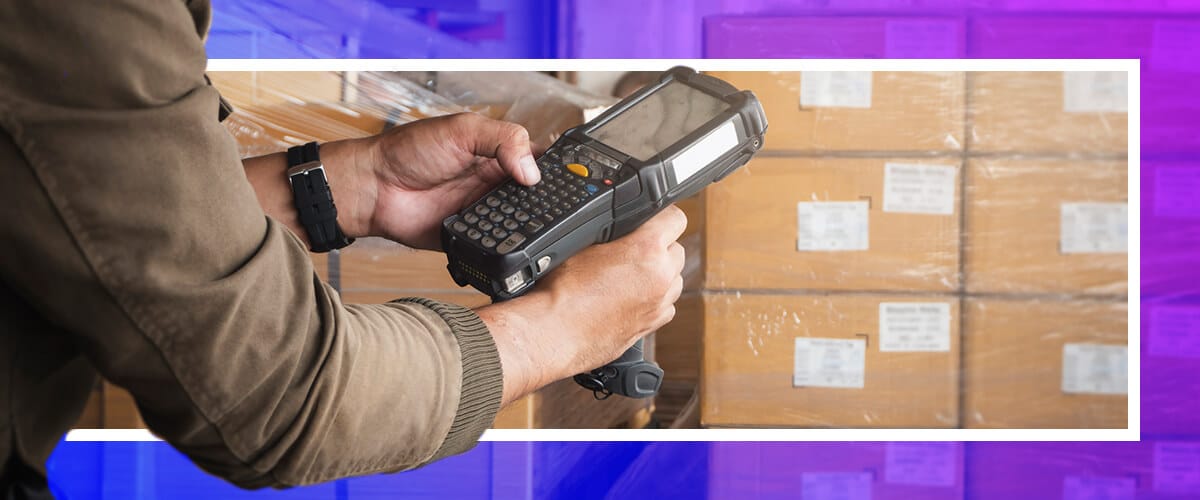Strategies such as directed putaway, robotics integration, and automated picking systems can help warehouses significantly reduce employee travel time, leading to faster order processing and improved worker satisfaction. This article will show you how pickers can travel your warehouse less while accomplishing more.
- The impact of picker travel time on warehouse efficiency
- Implementing smart slotting strategies
- Harnessing warehouse robotics and automation
- Optimizing warehouse layout and picking strategies
- Integrating technology for real-time optimization
- Work smarter with Logiwa
- FAQs on reducing picker travel time in the warehouse
The impact of picker travel time on warehouse efficiency
A warehouse’s labor costs accounts for a large portion of their total expenses, and much of it comes from walking distances. Before picking, packing, kitting, assembly, and shipping, workers make the trek through the warehouse. Reducing walking distances is the first step to improving the efficiency of your warehouse operations.
An effective warehouse layout optimization strategy can go a long way in reducing travel distances and enhancing your warehouse efficiency. A well-planned warehouse layout accounts for walking distances from the start, achieving benefits such as:
- Faster order fulfillment
- Greater worker productivity
- Higher order accuracy
- Fewer workplace injuries
By walking through your warehouse less, employees are not only safer and happier, but they can fill more orders with fewer errors as well.
Implementing smart slotting strategies
Smart slotting strategies can help reduce employee walking distances, and they’re essential for boosting your warehouse efficiency. They work by strategically placing inventory in convenient locations throughout the warehouse, so that employees only have to travel minimum lengths to fill orders. Some key components of smart slotting strategies are:
- ABC analysis and inventory categorization: Founded on the Pareto Principle — that 20% of your inventory drives 80% of your profits — an ABC analysis aims to categorize your inventory, placing the highest-selling products closest to pickers. The three categories are: A) high-value, requires high-control, B) medium-value, requires medium control, and C) low-value, requires minimum control. With these categories, employees can access the most in-demand products more easily, and store them in the proper conditions.
- Dynamic slotting with machine learning: Powered by machine learning algorithms, dynamic slotting analyzes inventory data to optimize product placement in real-time. Inventory location is chosen based on factors such as seasonality, velocity, and turnover rates, placing faster moving products in the front and slower-moving ones in the back. The result is reduced travel time and increased picking speed, improving warehouse efficiency.
- Zone-based slotting: Instead of organizing inventory according to purchasing data, some fulfillment centers divide their space into zones based on product characteristics. Zone picking minimizes the amount of required movement through the warehouse by assigning workers to designated areas, which improves order accuracy by confining picking to certain regions. The shorter walking distance also improves picking speed, resulting in faster order fulfillment.
Organizing inventory by value, changing the layout by product data, and designating workers to specific areas within a facility — these smart slotting strategies all let you make the most of your space. They help you boost your operational efficiency by reducing picker travel time, and they even improve worker safety and satisfaction, cutting your labor costs at the same time.
Unlock a personalized tour of Logiwa IO
Harnessing warehouse robotics and automation
It takes more than human employees to fulfill the massive number of orders that consumers place in today’s ecommerce-driven economy. Warehouse automation solutions can further enhance the productivity of human pickers by reducing the number of repetitive tasks they perform, and by cutting down on their steps. Implementing warehouse robotics can revolutionize your operations, so consider investing in:
- Autonomous mobile robots (AMRs): AMRs can transport goods within the warehouse to reduce picker travel. These warehouse innovations are particularly flexible and scalable for existing warehouse layouts, adapting to inventory arrangement whenever it changes and making processes more agile.
- Goods-to-person (G2P) systems: Similar to moving goods within a facility as AMRs do, G2P systems deliver items directly to pickers. This eliminates walking distances altogether, delivering significant gains in efficiency and reductions in labor costs — and maximizing ROI.
- Collaborative robots (cobots): Rather than replacing human workers, cobots assist employees as they handle repetitive or dangerous tasks. The result is not only better productivity, but also fewer workplace injuries.
While implementing warehouse robotics can require some upfront investment, the payoff can be worthwhile. Warehouse automation solutions enhance productivity, improve order accuracy, and foster greater workplace safety, creating a better environment for suppliers and workers alike.
Optimizing warehouse layout and picking strategies
Even with the right products in the right places and the right technology to pick them, the layout of the warehouse is still a critical factor in determining walking distance and workers’ efficiency. Optimizing warehouse layout involves more than spatial considerations — it requires a systematic picking procedure as well. Some factors to consider are:
- Efficient warehouse design: A simple, logical design can go a long way in optimizing a warehouse layout. Vertical storage and adjustable shelving systems help maximize available space, and clear pathways are essential for avoiding an accident.
- Batch and wave picking: Batch picking involves grouping orders together and picking them at the same time, while wave picking bases inventory selection on a set of criteria, such as product features or the need for a forklift. Whichever picking scheme you choose, make sure it reduces the number of trips required of your employees while improving order accuracy and productivity.
- Waveless picking and dynamic order prioritization: Rather than wait for batch requirements to come in, waveless picking grabs inventory as orders are placed in real time. Dynamic order prioritization also enhances warehouse efficiency, as workers are instructed to adjust their workflows according to incoming order analysis.
With an efficient warehouse design and picking schedule in place, human and robotic workers can both improve their picking accuracy and fill orders at a pace consumers demand.
Integrating technology for real-time optimization
While waveless picking and dynamic order prioritization are essential for keeping up with today’s ecommerce environment, successful implementation depends upon having the right technology in place. For example, warehouse management systems (WMS) facilitate real-time inventory tracking and slotting, offering pick path optimization and dynamic slotting recommendations. AI and machine learning applications also help by analyzing fulfillment data to continuously improve warehouse operations, and predictive analytics functionalities assist with demand forecasting and inventory management, keeping warehouses prepared.
Work smarter with Logiwa
An optimized warehouse layout will take a holistic approach to maximizing its productivity. It will implement directed putaway (smart slotting) to ensure that all products are in the right place at the right time, robotics to enhance picking accuracy and productivity, and AI to analyze order fulfillment data and optimize warehouse efficiency. The right combination of technology and design not only results in enhanced employee satisfaction, but in greater throughput and higher profits — and Logiwa IO, an advanced fulfillment management system (FMS) makes it all possible..
Logiwa IO is powered by industry leading AI algorithms, helping you collect and analyze data to elevate your warehouse efficiency. Logiwa IO facilitates warehouse automation solutions and layout optimization, reducing picker travel time, expediting order fulfillment, and streamlining your operations. To see how we can help your employees work smarter, request a demo of Logiwa IO today.
FAQs on reducing picker travel time in the warehouse
How does reducing picker travel time improve a 3PL's warehouse efficiency?
- Faster Order Fulfillment: Less travel time directly speeds up the entire fulfillment process.
- Increased Productivity and Volume: When employees walk less, they can fill more orders, which increases fulfillment volume.
- Lower Labor Costs: Labor is a large portion of a warehouse’s expenses, and much of that cost comes from pickers’ walking distances.
- Higher Order Accuracy: Shorter travel paths can lead to fewer picking errors.
- Improved Worker Satisfaction and Safety: Less walking results in happier, safer employees and fewer workplace injuries.
What smart slotting strategies can a 3PL implement to reduce picker walking distance?
- ABC Analysis: This method uses the Pareto Principle, suggesting 20% of inventory drives 80% of profits. It involves categorizing products (A, B, C) based on their value and placing the highest-selling, most in-demand items closest to pickers for easier access.
- Dynamic Slotting: This strategy uses machine learning to analyze inventory data like seasonality and velocity in real-time to optimize product placement. Faster-moving items are placed in more accessible locations, reducing travel time and boosting picking speed.
- Zone-Based Slotting: This approach divides the warehouse into distinct zones and assigns workers to specific areas. This minimizes movement throughout the facility, which improves picking speed and order accuracy.
How can automation and robotics help a 3PL reduce picker travel time?
- Autonomous Mobile Robots (AMRs): AMRs transport goods within the warehouse, which reduces the need for pickers to travel. They are flexible and can adapt to changing warehouse layouts.
- Goods-to-Person (G2P) Systems: G2P systems deliver items directly to stationary pickers, which can eliminate walking distances entirely. This leads to significant gains in efficiency and reductions in labor costs.
- Collaborative Robots (Cobots): Cobots work alongside human employees, assisting them with repetitive or dangerous tasks. This collaboration improves productivity and results in fewer workplace injuries.
What picking strategies are most effective for optimizing a 3PL warehouse layout?
- Batch and Wave Picking: Batch picking involves grouping different orders together to be picked simultaneously. Wave picking organizes inventory selection based on criteria like product features. Both methods are designed to reduce the total number of trips employees need to make.
- Waveless Picking and Dynamic Order Prioritization: Instead of waiting for batches to be assigned, waveless picking allows for inventory to be picked as soon as an order is placed. This is complemented by dynamic order prioritization, where workers are instructed to adjust their tasks based on real-time analysis of incoming orders to enhance efficiency.
What technology is essential for a 3PL to enable real-time warehouse optimization?
- Warehouse Management Systems (WMS): A WMS provides real-time inventory tracking and offers features like pick path optimization and recommendations for dynamic slotting.
- Artificial Intelligence (AI) and Machine Learning: AI and machine learning applications are used to analyze fulfillment data, which helps to continuously improve warehouse operations.
- Predictive Analytics: This functionality aids in demand forecasting and inventory management, ensuring a warehouse is prepared for future order volumes.





